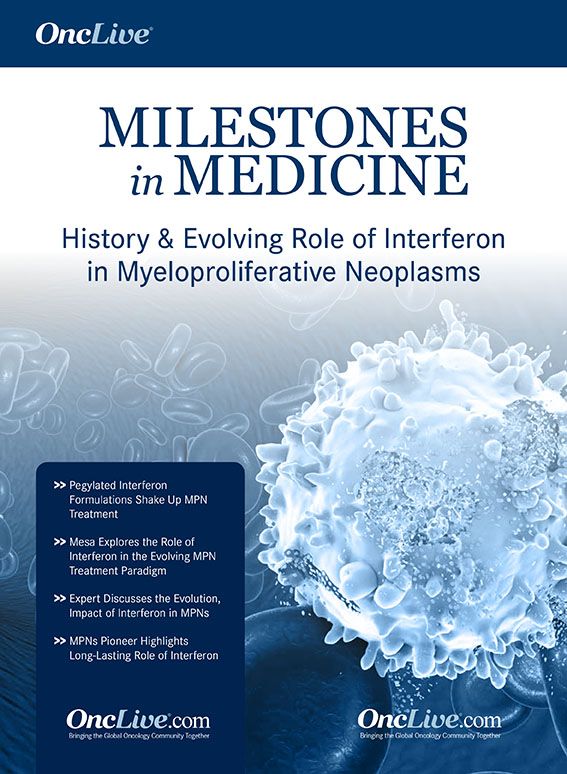Publication
Article
Supplements and Featured Publications
Expert Discusses Evolution, Impact of Interferon in MPNs
Author(s):
Srdan Verstovsek, MD, PhD, discusses the use of interferon in rare blood diseases.
Srdan Verstovsek, MD, PhD, associate professor of oncology and urology at Johns Hopkins Medicine

Srdan Verstovsek, MD, PhD
Limited research on interferon has prevented its widespread use in patients with myeloproliferative neoplasms (MPNs); however, newer generations of the treatment are demonstrating noninferiority to its favored counterpart, hydroxyurea, and are showing greater tolerability and efficacy compared with older generations of the agent, explained Srdan Verstovsek, MD, PhD.
“One needs to be selective in the patient population that is [receiving] interferon,” said Verstovsek. “Early evidence suggests that the long-acting and super long-acting interferon appears to be less toxic, even over a long period of time. This was not the case with earlier types of interferon that were given 3 or 5 times a week. The average duration of therapy was not too long, perhaps up to 5 years on average.”
With novel forms, that timespan may be prolonged, added Verstovsek. The ultimate goal is to give the therapy for decades, as patients with essential thrombocythemia (ET) or polycythemia (PV) live longer lives, close to a normal life expectancy.
OncLive: Could you provide a history of the use of interferon in MPNs?
In an interview with OncLive, Verstovsek, director of the Hanns A. Pielenz Clinical Research Center for Myeloproliferative Neoplasia at The University of Texas MD Anderson Cancer Center, discussed the use of interferon in these rare blood diseases.Verstovsek: Interferon is a biological product. We all have it in our body; it shows up when we have inflammation or infection. As such, it has been used in cancer therapy. It was discovered to be useful in patients with chronic diseases of the bone marrow. Interferon was standard of care in chronic myeloid leukemia (CML) until about 2001 because it would improve the bone marrow environment and decrease the number—sometimes even eliminate the number—of malignant cells in the bone marrow. Essentially, it would normalize the blood cell counts, thereby making some patients live longer. In CML, that was replaced by specific inhibitors in the early 2000s.
Interferon was also used in other MPNs, such as PV, ET, and sometimes, in myelofibrosis. In this setting, interferon was as effective as in CML, in normalizing the bone marrow and providing long-term control of the blood cell count. Some would even say that the long-term use of interferon in these conditions would prevent disease progression or eliminate the underlying malignant clone in some patients with CML, although that would be a rare success.
We began to use interferon in ET, PV, or myelofibrosis after developing a long-acting interferon that’s given once a week. Interferon is a biological protein, so it cannot be given by mouth; instead, it’s given by injection. Traditional interferon has been given by injection 3 to 5 times a week. The long-acting interferon is a slow release that can be given once a week.
Some of the newer [generations] that are being developed in Europe are given even less frequently—every 2 weeks or even once a month. That’s important because interferon does carry some toxicity; it may make people feel unwell, resulting in flu-like symptoms.
However, long-acting interferon appears to be decreasing the frequency of adverse events and increasing the tolerability and efficacy. That appears to be the case, especially with the most recent development of the super long-acting interferon in Europe called ropeginterferon.
Could you discuss ropeginterferon and its potential in this space?
That is certainly reflected in the higher efficacy and long-term efficacy [rates]. Durability is another issue. If you have an active agent that [remains active for a very long period of time], there are some toxicities that develop later in the course of the therapy, including autoimmune conditions or depression.Ropeginterferon was recently approved in Europe; the announcement was made in December 2018 for the treatment of patients with PV. We hope that we will have that particular medication here in the United States, in clinical studies, in the very near future.
What are the main differences between the different generations of interferon?
In the meantime, we are using interferon alfa-2b or interferon alfa-2a once a week off-label; these are both pegylated forms of interferon that are slow release, known commercially as peginterferon (Pegasys). Studies are being done in academic centers to compare the use of these long-acting interferons with standard chemotherapy: hydroxyurea. A study that compared hydroxyurea with peginterferon showed equal efficacy and tolerability. In Europe, ropeginterferon proved to be superior to hydroxyurea.Standard, short-acting interferon is given 3 to 5 times per week. It circulates through the body and goes away quickly. That's why we give it so often. Pegylated forms that are commercially available for hepatitis and used off-label for PV and ET are given weekly.
Could you elaborate on the study that compared interferon with hydroxyurea?
Ropeginterferon has a different chemistry. The pegylated form is different, so it can be given every 2 weeks. After 1 year of therapy, most people in the clinical study were switched over to monthly injections; that is because of a chemical property [within] the pegylated part of the construct of the medication. That leads to easier delivery to patients and decreased frequency, thereby increasing tolerability. The long-term toxicities on the liver, for example, might be positively affected by decreasing the frequency of the injections.The studies that addressed this were presented at the 2018 ASH Annual Meeting and focused on PV. A study through the Myeloproliferative Disorders Research Consortium led by John Mascarenhas, MD, from Mount Sinai Health System, was an update of a study comparing peginterferon with hydroxyurea in treatment-naïve patients with PV. After about 2 years of follow-up, interferon was shown to be noninferior to hydroxyurea in terms of controlling blood cell count, molecular response, and tolerability. These findings confirm the National Comprehensive Cancer Network guidelines for interferon use in practice.
However, in practice, hydroxyurea is used more often than interferon. Many patients are exposed to hydroxyurea first, and then, only if necessary, receive interferon later on. That is with the exception of younger patients and females. That may change with these studies that are confirming the noninferiority between the 2 approaches.
What are some potential avenues for future research with interferon?
The real advantage [was seen in] the European study that compared ropeginterferon with hydroxyurea. In this study, the super long-acting interferon was given every 2 weeks and then once a month after longer exposure to an every-2-weeks schedule. Three-year follow-up data were presented from that study and showed clear evidence demonstrating the superiority of interferon to hydroxyurea. The tolerance rate was very good; the dropout rate was low. There was a decrease in the molecular clone or abnormality in patients who were exposed to ropeginterferon from the beginning of the study. At the beginning of the study, hydroxyurea was more effective because it works faster. As hydroxyurea lost its benefit, interferon picked up. Based on these follow-up data, interferon appears to be better both in terms of clinically relevant findings as well as in biological correlates.Ropeginterferon is approved in Europe for PV, and we expect an attempted approval in the United States for PV and ET sometime [in 2019]. Myelofibrosis may be another possibility.
The next logical step would be combination therapies with interferon in either ET or PV. Studies with interferon and ruxolitinib (Jakafi), the JAK1/2 inhibitor approved for PV and myelofibrosis, are underway. One study is being conducted in Denmark and one is being conducted in France. Some preliminary results were already presented at the 2018 ASH Annual Meeting. However, these results are too early to get a sense of the overall benefit of the combination.
Interferon has multiple mechanistic effects on the bone marrow environment. Combining the 2 biological agents may induce a biologic effect on the disease with the potential to normalize the bone marrow, perhaps even eliminate the malignant clone in the majority of patients. Utilizing ropeginterferon outside of MPNs can be contemplated, although the focus at the moment is to expand its use within this group of blood diseases.























%20(2)%201-Recovered-Recovered-Recovered-Recovered-Recovered-Recovered-Recovered-Recovered-Recovered-Recovered-Recovered-Recovered-Recovered-Recovered-Recovered-Recovered-Recovered.jpg?fit=crop&auto=format)
%20(2)%201-Recovered-Recovered-Recovered-Recovered-Recovered-Recovered-Recovered-Recovered-Recovered-Recovered-Recovered-Recovered-Recovered-Recovered-Recovered-Recovered-Recovered.jpg?fit=crop&auto=format)
